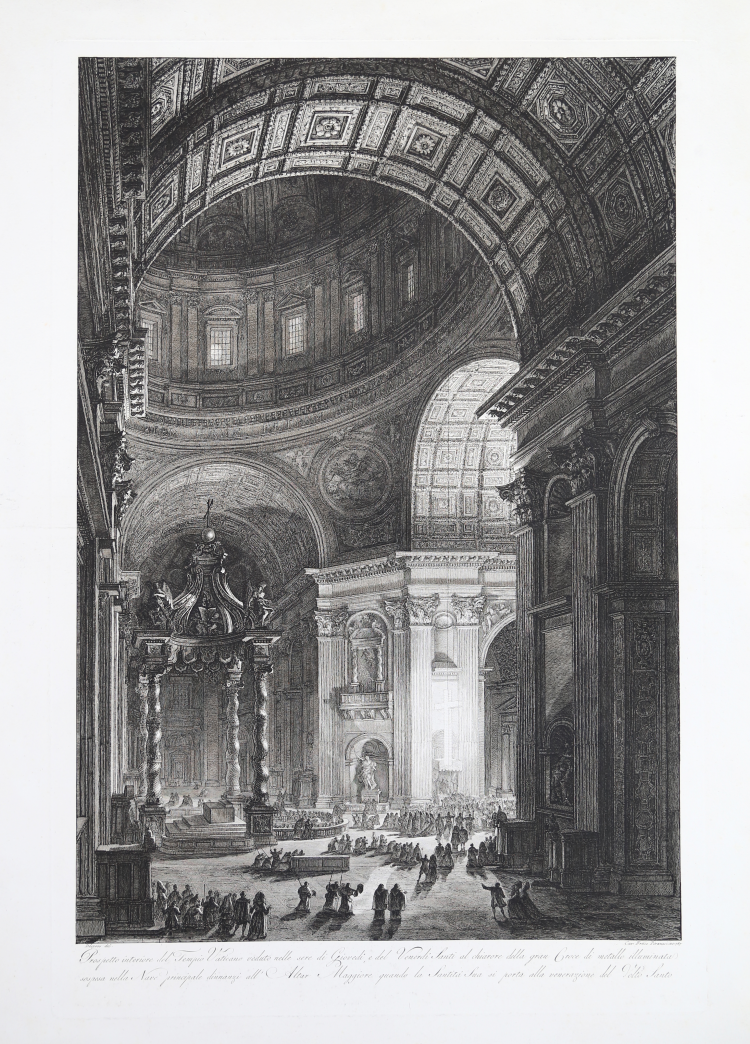



| Reference: | S40500 |
| Author | Francesco PIRANESI |
| Year: | 1787 |
| Zone: | San Pietro |
| Printed: | Rome |
| Measures: | 775 x 510 mm |


| Reference: | S40500 |
| Author | Francesco PIRANESI |
| Year: | 1787 |
| Zone: | San Pietro |
| Printed: | Rome |
| Measures: | 775 x 510 mm |
Etching and engraving, circa 1783 from a subject by Louis Jean Desprez.
Example of the second state, inscribed Prospetto interiore del Tempio Vaticano ... Dêspres del. Ca. Frañco Piranesi inc. 1787.
Magnificent proof, printed on contemporary laid paper, with full margins, in excellent condition.
The representation of religious ceremonies inside the most important churches, first of all St. Peter's, was widespread in the eighteenth century. The trade of views linked to foreign clients did not fail, in fact, to provide suggestive images of these liturgies that aroused considerable curiosity in travelers visiting Rome. It was, in fact, a widespread custom in the itinerary followed by grandtourists in Italy to make sure to follow the religious functions of Easter week in Rome. Giá Lalande (cf. Voyage d'un François en Italie, fait dans les années 1765 et 1766, Venice and Paris 1769, V, p. 122), who had been able to witness the ceremony of the cross during his trip in 1766, tells, in fact, of "a cross eighteen to twenty feet high, illuminated in the evening with oil lamps that offers a spectacular view."
The same scene is also depicted in a series of hand-colored engravings resulting from the collaboration between Francesco Piranesi and Louis Jean Desprez. The framing is almost the same, in both views the ceremony is taken from the left transept so as to frame Bernini's canopy illuminated by the reflections of light, allowing one to distinguish the silhouette of St. Longinus on the piliere of the dome. The vertical cut of the engraving by Piranesi and Desprez leaves less space for architectural details; the interior of St. Peter's with the ceremony of the Cross is also reproduced by Desprez in a drawing now at the Louvre taken from a different point of view, so that only a small part of the canopy can be seen (see Fabrizia Lucilla Spirito, Vedutismo e Grand Tour: Giovan Battista Lusieri e i suoi contemporanei, Naples 2006, p. 52).
Beautiful example.
Bibliografia
Wollin, Nils Gustaf, Desprez en Italie; dessins topographiques et d'architecture (1935), p. 156, n. 1, II/II.
Francesco PIRANESI (Roma 1758 - Parigi 1810)
|
Son of Giovanni Battista, and heir to his plates. Etcher and publisher in Rome; held office in the Roman Republic of 1798, and had to flee with all his plates to Paris in 1799, where he established (with his brothers Peter and Laura, also engravers), the Chalcographie Piranesi des Frères and a factory of terracotta of ancient models. Francesco (1758–1810), who played an important part in completing his father's later works, notably the Vasi…Francesco Piranesi published a map of the Villa Adriana, Tivoli (1781), and added new plates to further editions of the Vedute, Antichità, and other works. Most importantly, he issued a massive collection of graphic works in 27 volumes (1800–7) as well as a three-volume set of Antiquités de la Grande Grèce (1804–7) based on his father's work at Pompeii.
|
Francesco PIRANESI (Roma 1758 - Parigi 1810)
|
Son of Giovanni Battista, and heir to his plates. Etcher and publisher in Rome; held office in the Roman Republic of 1798, and had to flee with all his plates to Paris in 1799, where he established (with his brothers Peter and Laura, also engravers), the Chalcographie Piranesi des Frères and a factory of terracotta of ancient models. Francesco (1758–1810), who played an important part in completing his father's later works, notably the Vasi…Francesco Piranesi published a map of the Villa Adriana, Tivoli (1781), and added new plates to further editions of the Vedute, Antichità, and other works. Most importantly, he issued a massive collection of graphic works in 27 volumes (1800–7) as well as a three-volume set of Antiquités de la Grande Grèce (1804–7) based on his father's work at Pompeii.
|